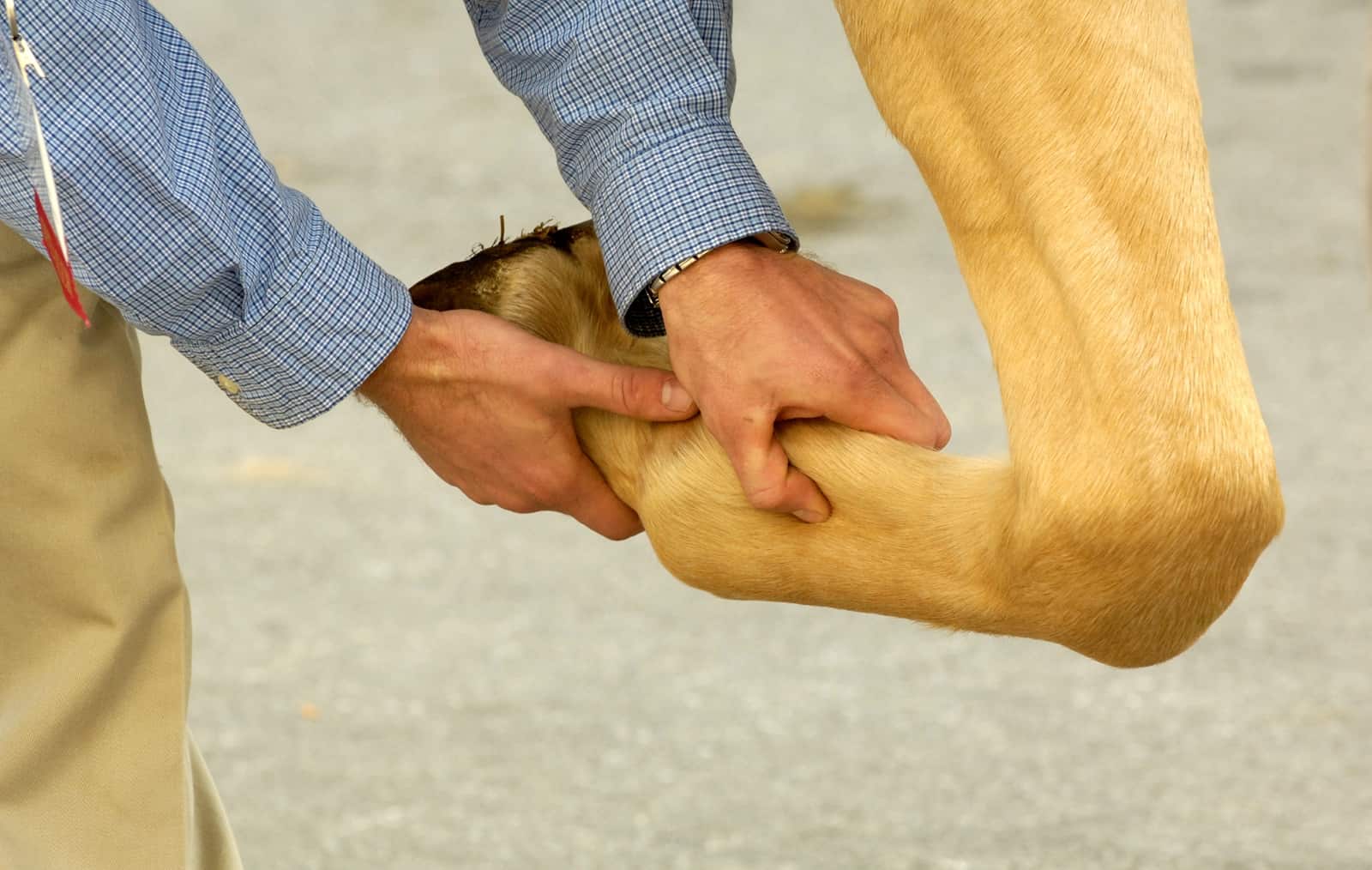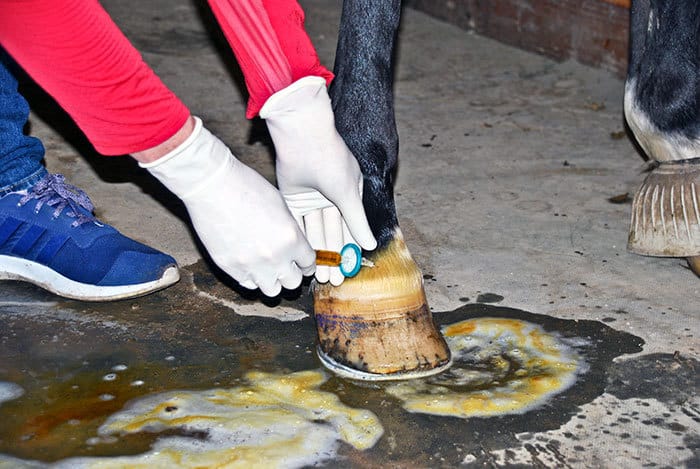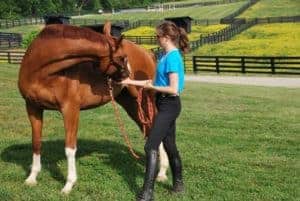The Road to Recovery: Rehabilitating Horses With Lower-Limb Injuries

What to consider when you’re rehabilitating horses with lower-limb injuries
It’s frustrating when a horse comes up lame. Missed training, competitions, and, simply, time in the saddle can be disappointing and expensive. Regardless of the cause, rehabilitation—starting from time of diagnosis and continuing to return to normal work—is key.
“For me, the entire rehab process is considered physical therapy,” says Carrie Schlachter, VMD, Dipl. ACVSMR, medical director at Circle Oak Equine, a lameness, sports medicine, and rehabilitation practice in Petaluma, California.
In the first installment of this two-part series, we looked at restoring the upper body to normal function after injury. Now we’ll focus on limb issues, from therapies to back-to-work schedules.
But First, Prevention Methods
The best-case scenario, of course, is to prevent injuries from occurring in the first place. “Just like a human athlete, the horse has to be properly conditioned,” says Stephen Denton, DVM, owner of Abingdon Equine Veterinary Services, in Virginia, and provider of sports medicine and lameness services through Performance Equine Vets, in Aiken, South Carolina. “The muscles need to be strengthened properly. A lot of our injuries occur when the muscles fatigue—the ligaments and tendons get weaker and then are prone to joint injury and tendon/ligament injury from there.”
To that end, Denton recommends owners perform exercises to build the horse’s core, working on different surfaces, cross-training, and keeping the horse in a regular exercise program.
“For prevention, trainers and owners need to keep fitness in mind—not only muscular and cardiovascular but hoof, ligament, tendon, and bone,” says Schlachter. “Most horses that participate in any sort of speed event should be able to trot 20 minutes uninterrupted, which is approximately 4 miles.”
Denton says this preparation, which he calls “prehabilitation,” starts early in life. “Prevention of joint, tendon, and ligament injuries actually begins with foals,” he says. “We’ve done enough studies to know if they are not moderately exercised and are stalled all the time, their cartilage thickness and tendon/ligament strength is not as good as it would be if they had had a lot of exercise and turnout when they were young. I make sure my clients with youngsters have them get proper exercise from Day 1.”
Find Your Baseline
Establishing a baseline when the horse is sound and in work, as well as when sidelined with an injury, is essential to good management, says Denton, who uses a field-based lameness measurement system for this purpose. “It will pick up a lameness before you can see it,” he says.
The measurements serve as a starting point for treatment and rehabilitation. “This way I can follow through with objective data,” he says. “With a baseline, you can go back to see exactly how much improvement there is.”
A soundness evaluation before show season starts is also useful. “If you catch something and treat it early, you have the best outcome,” says Denton. “I ask clients to be proactive. Palpate for heat and swelling. Don’t mask problems with anti-inflammatories and keep working; it could go from a mild strain to a tear, causing the joint to become more inflamed and do more damage to the cartilage.”
Healing Phase Protocols
Once diagnosed, treatment and rehabilitation can begin. Assemble a knowledgeable veterinary and management team that can tailor a plan to address your specific situation. “In the limbs, we’re worried about tendon, ligament, bones, hoof capsule, and fascia (connective tissue that surrounds muscles and muscle groups), which … is still poorly understood,” says Schlachter. As a very general rule, Denton and Schlachter adopt the following big-picture rehabilitation approaches for treating each of these areas.
Soft tissue
While in the acute phase, one to three weeks post-injury, Denton recommends rest with the goal of halting inflammation, including icing the injury, bandaging, and administering anti-inflammatories. Denton says it takes 10 to 15 minutes of ice application to lower the temperature to an effective level, but warns against overdoing it. Total icing time should take 20 to 30 minutes.
Once the inflammation settles, usually around Week 3, the healing phase begins, which, he says, is an ideal time to target the area with various therapies. He uses regenerative medicine, shock wave, or ultrasound, followed by underwater treadmill sessions to reintroduce work while reducing the load on the affected tendon or ligament.
Dr. Carrie Schlachter
Ligament injuries, says Schlachter, make up the bulk of limb insults she sees in her practice, where she treats primarily middle-aged sport horses. “The vast majority of ligament injuries respond really well to a course of controlled exercise,” she says. “The next thing I would go to is shock wave, and the third direction I would go to is regenerative medicine.”
Schlachter says tendon injuries require a different approach. “Tendon injuries tend to heal faster and better than ligament injuries,” she says. Her gamut of therapies for these injuries runs from platelet-rich plasma (PRP) injections and laser to shock wave and functional electrical stimulation (FES). She says she uses PRP to deliver a high concentration of platelets in the form of blood plasma to a lesion, increasing the amount of growth factors at the site to help the injury heal, and applies cold laser to treat edema (fluid swelling) and inflammation. Schlachter finds shock wave useful for chronic issues, particularly those with scar tissue, and she employs FES and therapeutic ultrasound for re-injuries or old tendon injuries that aren’t acutely inflamed.
Additionally, “the underwater treadmill is amazing for scar tissue in the lower legs,” she says, noting that she’s seen it “really increase range of motion.”

Joints
“If I diagnose … a joint issue, depending on what I find on diagnostic X ray and ultrasound, we’ll usually be looking at some sort of intra-articular medication: steroids, polysulfated glycosaminoglycan and amikacin, hyaluronic acid, IRAP (interleukin-1 receptor antagonist protein), stem cells, or PRP,” says Denton of his typical joint injury protocol. “We’ll possibly perform arthroscopic surgery (where the surgeon inserts an endoscope into the joint through a small incision to look for damage), depending on what we find, which we may also use as an exploratory measure to see if there’s something that can be repaired.”
He doesn’t usually apply laser or shock wave to joints, but does use ultrasound therapy for lower joints. “I tend to go with intra-articular medications, range of motion exercises, underwater treadmill, and anti-inflammatories,” Denton says.
Hoof capsule
For injuries below the proximal (upper) suspensory ligament that runs down the back of the cannon bone, Schlachter says she often looks to the hoof capsule for the root issue. “The hoof needs to be balanced 365 degrees: from medial to lateral (side to side) and dorsal to plantar/palmar (from the hoof wall to the sole and rear of the foot),” she says. “If the shoeing cycle is inconsistent, there are weak spots and strong spots in the hoof capsule; these pressure points can result in unnecessary inflammation.”
Other causes of hoof capsule problems can include changing farriers and trying different types of shoes over a short period, she says. “Luckily, the hoof capsule is elastic in comparison to the rest of body, so if there is damage, the horse can be brought back pretty easily as long as there hasn’t been an underlying injury.”
On occasion, the hoof just needs some R and R, says Schlachter. “Two to four weeks on the underwater treadmill for horses that just need a break is amazing,” she says. “They feel so much better after doing a completely different decreased-weight-bearing exercise.”
Timelines to Soundness
Restoring the horse to soundness looms at the top of every owner’s mind when looking at rehabilitation, along with just how long that might take. While slow and steady wins the race, it doesn’t mean you need to keep your horse stall-bound.

“We know with tendon and ligament injuries that some motion (e.g., hand-walking) needs to start fairly early if possible,” says Denton. “Once the inflammation is down, walking will load the limb and apply light tension/stretching on the injured tendon or ligament more than standing in a stall will.”
Schlachter describes the protocol she typically follows in these situations: “From the moment the injury has been diagnosed, the horse goes onto a controlled exercise program, based on clinical findings. If the horse is still walking lame, they are on stall rest. If walking sound, which includes tight turns, but trotting lame, they start out at about 10 minutes of walk twice a day.
“This also my hallmark for differentiating between moderate and severe injuries,” she adds. “If the horse is 4 out of 5 lame at the walk at the time of the injury, even for just a day, there’s a good chance that injury is a severe injury.
“The level of work depends on what’s injured and how severe it is,” she says.
How fast the horse can progress in his recovery also depends on what the veterinarian sees on re-examination. Schlachter, for instance, evaluates and ultrasounds horses at the six- to eight-week and 12- to 16-week marks before clearing them for the next phase (e.g., tack-walking, trotting, etc.) in their rehabilitation.
Dr. Stephen Denton
Once past the initial hand-walking period, Denton says he increases movement slowly. “I generally have a three-month slow back-to-work program for ligament and tendon injuries,” he says. “This includes tack-walking, adding trot sets, and then canter sets over three months, increasing the trot and canter sets, always starting and ending with walk. At the end of that three-month buildup, they are usually easily able to handle 15 to 30 minutes of walking, 15 minutes of trot, and 15 minutes of canter. Once they can do that, they go back into their discipline work, easing in and slowly increasing that type of work, as well.”
For joint recovery Denton follows the same three-month schedule, while also including ground poles to improve range of motion and client-performed flexion and extension physical therapy exercises. He also places horses on the submerged treadmill to rebuild muscle without concussing the joint, particularly after surgery or a major injury. For each session he recommends first applying heat to loosen and limber the joint and icing the joint afterward to reduce inflammation.
Schlachter says with acute soft-tissue injuries, she waits until the injury is past the inflammatory phase to begin rehabilitation—approximately 30 days. In the case of proximal hind suspensory injuries she waits about 45 to 60 days, because she finds the increased range of motion and extended caudal phase of the hind-limb stride cause this injury to persist. Citing her own experience, Schlachter says chronic soft-tissue cases, on the other hand, might respond well to the underwater treadmill and shock wave therapy.
“For mild tendon injuries, you’re generally looking at six months until back in full work, longer for more severe injuries,” she says. “A ligament injury, on the other hand, may be eight to nine months unless severe, in which case it’s a year and a half to two years. The exception to the tendon rule would be the deep digital flexor tendon, which may take a year and a half to two years. A lot these cases are chronic, but can come back with enough time to decrease inflammation and increase the tensile strength of tendon.”
Be Proactive, Remain Hopeful
Don’t hesitate to call your veterinarian when you realize something isn’t right. “The best chance to correct a lameness is in the acute phase,” says Denton. “If you notice something is wrong with your horse, don’t wait. We can come up with a therapeutic plan and rehabilitation. Overall we see more improvement when we use modalities than when we don’t.”
Have faith in the process, and work closely with a good veterinary team. And, says Schlachter, “Be patient. It’s always two steps forward and one step back.”
Written by:
Natalie DeFee Mendik, MA
Related Articles
Stay on top of the most recent Horse Health news with











